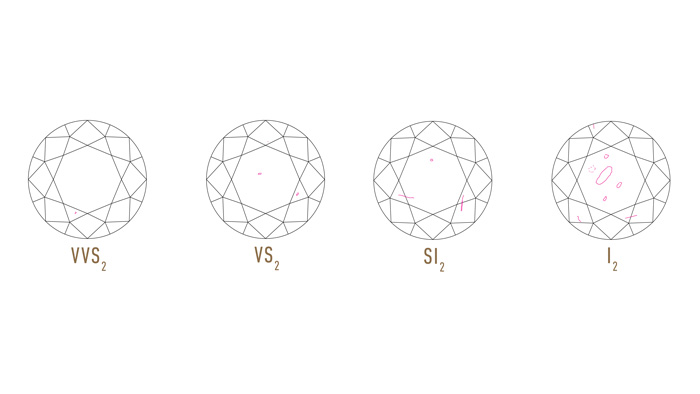Diamond clarity is the assessment of surface defects (blemishes) and internal defects (inclusions) of a stone. Nearly all diamonds have inclusions and blemishes, but the most valuable diamonds are flawless.
The location, size, number, and visibility of inclusions will impact the clarity grade of a diamond. If an inclusion is closer to the girdle (outermost edge) it will have less of an effect on the clarity grade than if the inclusion was in a more prominent spot.
Some types of diamond inclusions are pinpoints, crystals, feathers, or cavities. Inclusions can form during the diamond creation process or the diamond cutting process. Since diamonds form under such extreme conditions, nearly all of them contain external or internal unique characteristics. Inclusions can be caused by tiny mineral crystals or diamonds that can get trapped inside or irregular crystal growth. When selecting stylish diamond rings Scottsdale jewelers offer, understanding these inclusions can help you choose a diamond that balances clarity with other desirable features, ensuring you find a ring that’s both beautiful and unique.

The Gemological Institute of America (GIA) came up with a clarity grading system to standardize how jewelers talked about the clarity of diamonds. The diamond clarity scale has 6 categories with 11 total grades. This standardized system is crucial when evaluating elegant Phoenix diamond rings, as it helps customers understand the quality and value of the diamonds they’re considering, ensuring they make informed decisions when selecting their perfect ring.
Flawless (FL) – No internal or external flaws. Extremely rare.
Internally Flawless (IF) – No internal flaws. Inclusions are not visible under 10x magnification. When shopping for unique diamond rings in Tempe, this level of clarity is highly prized and can contribute significantly to the overall beauty and value of the ring, making it an excellent choice for those seeking exceptional quality in their diamond jewelry.
Very Very Slightly Included (VVS1, VVS2) – Difficult to see inclusions under 10x magnification.
Very Slightly Included (VS1, VS2) – Usually cannot see inclusions with the naked eye. When participating in diamond auctions, this characteristic is an important factor to consider. A guide to diamond auctions would emphasize the significance of this clarity grade, as it represents diamonds that appear flawless to the unaided eye, potentially affecting bidding strategies and overall value assessment in auction settings.
Slightly Included (SI1, SI2) – Inclusions are visible under 10x magnification.
Included (I1, I2, I3) – Obvious inclusions that are visible under 10x magnification. Inclusions likely to impact beauty.
Diamond grading reports from the GIA sometimes contain a clarity plot that maps out characteristics of your diamond such as inclusions. The clarity plot is shaped like a diamond, so you get a visual of where different features on your diamond appear. This information is particularly valuable when you decide to sell your gold and diamonds, as it provides potential buyers with a clear understanding of your diamond’s unique characteristics, potentially influencing its value and marketability.
Diamond clarity is important because if a diamond has poor clarity the inclusions and blemishes will cause the diamond to appear less bright and sparkly. When purchasing a diamond, it is important to understand the unique inclusions of your specific diamond. Depending on the inclusions, the diamond can still look inclusion free to the naked eye. However, clarity becomes even more important because it is more noticeable when purchasing larger diamonds. To further your diamond education read about diamond color and diamond carat weight.
Do you have a vision for your custom engagement ring, but aren’t sure how to make it a reality? Allow us to guide you through the process of how to create truly exceptional rings. Schedule your design appointment today and see how Finer Custom Engagement Rings and Diamonds will bring your vision of an engagement ring to life.
© Copyright Finer Custom Jewelry 2024